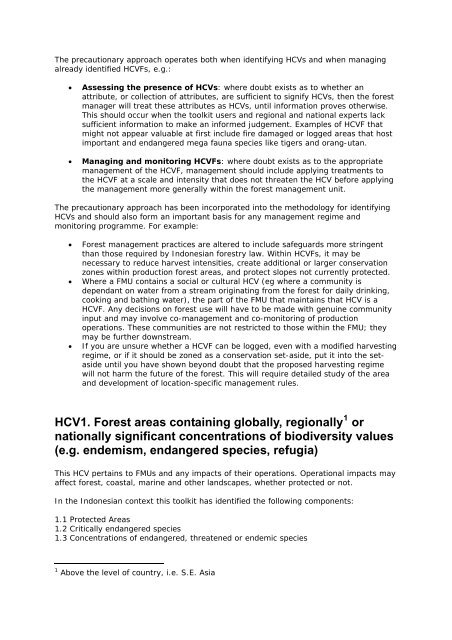English - HCV Resource Network
English - HCV Resource Network
English - HCV Resource Network
You also want an ePaper? Increase the reach of your titles
YUMPU automatically turns print PDFs into web optimized ePapers that Google loves.
The precautionary approach operates both when identifying <strong>HCV</strong>s and when managing<br />
already identified <strong>HCV</strong>Fs, e.g.:<br />
• Assessing the presence of <strong>HCV</strong>s: where doubt exists as to whether an<br />
attribute, or collection of attributes, are sufficient to signify <strong>HCV</strong>s, then the forest<br />
manager will treat these attributes as <strong>HCV</strong>s, until information proves otherwise.<br />
This should occur when the toolkit users and regional and national experts lack<br />
sufficient information to make an informed judgement. Examples of <strong>HCV</strong>F that<br />
might not appear valuable at first include fire damaged or logged areas that host<br />
important and endangered mega fauna species like tigers and orang-utan.<br />
• Managing and monitoring <strong>HCV</strong>Fs: where doubt exists as to the appropriate<br />
management of the <strong>HCV</strong>F, management should include applying treatments to<br />
the <strong>HCV</strong>F at a scale and intensity that does not threaten the <strong>HCV</strong> before applying<br />
the management more generally within the forest management unit.<br />
The precautionary approach has been incorporated into the methodology for identifying<br />
<strong>HCV</strong>s and should also form an important basis for any management regime and<br />
monitoring programme. For example:<br />
• Forest management practices are altered to include safeguards more stringent<br />
than those required by Indonesian forestry law. Within <strong>HCV</strong>Fs, it may be<br />
necessary to reduce harvest intensities, create additional or larger conservation<br />
zones within production forest areas, and protect slopes not currently protected.<br />
• Where a FMU contains a social or cultural <strong>HCV</strong> (eg where a community is<br />
dependant on water from a stream originating from the forest for daily drinking,<br />
cooking and bathing water), the part of the FMU that maintains that <strong>HCV</strong> is a<br />
<strong>HCV</strong>F. Any decisions on forest use will have to be made with genuine community<br />
input and may involve co-management and co-monitoring of production<br />
operations. These communities are not restricted to those within the FMU; they<br />
may be further downstream.<br />
• If you are unsure whether a <strong>HCV</strong>F can be logged, even with a modified harvesting<br />
regime, or if it should be zoned as a conservation set-aside, put it into the setaside<br />
until you have shown beyond doubt that the proposed harvesting regime<br />
will not harm the future of the forest. This will require detailed study of the area<br />
and development of location-specific management rules.<br />
<strong>HCV</strong>1. Forest areas containing globally, regionally 1 or<br />
nationally significant concentrations of biodiversity values<br />
(e.g. endemism, endangered species, refugia)<br />
This <strong>HCV</strong> pertains to FMUs and any impacts of their operations. Operational impacts may<br />
affect forest, coastal, marine and other landscapes, whether protected or not.<br />
In the Indonesian context this toolkit has identified the following components:<br />
1.1 Protected Areas<br />
1.2 Critically endangered species<br />
1.3 Concentrations of endangered, threatened or endemic species<br />
1 Above the level of country, i.e. S.E. Asia

















